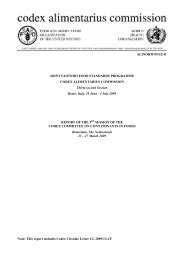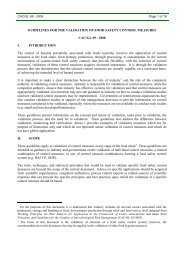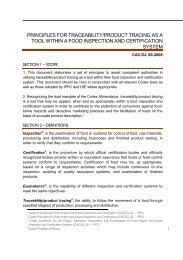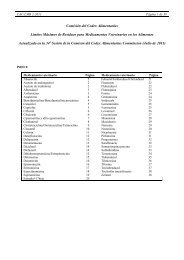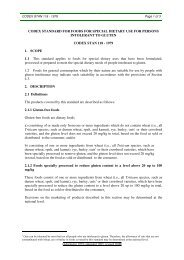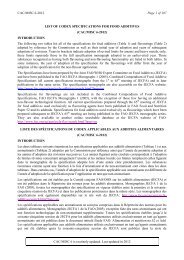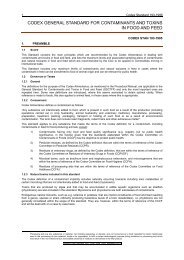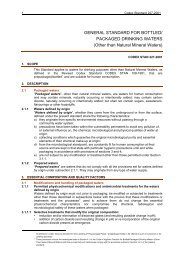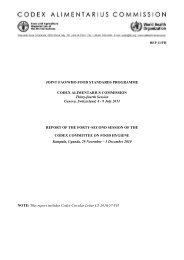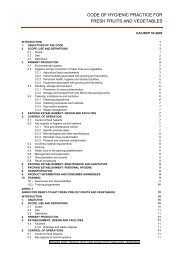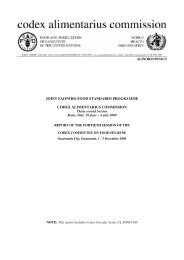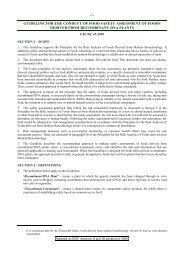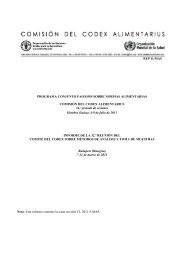General Standard for Food Additives - CODEX Alimentarius
General Standard for Food Additives - CODEX Alimentarius
General Standard for Food Additives - CODEX Alimentarius
You also want an ePaper? Increase the reach of your titles
YUMPU automatically turns print PDFs into web optimized ePapers that Google loves.
<strong>CODEX</strong> STAN 192-1995 Page 40 of 287<br />
12.5 Soups and broths:<br />
Includes ready-to-eat soups and mixes. The finished products may be water- (e.g., consommé) or milk-based<br />
(e.g., chowder).<br />
12.5.1 Ready-to-eat soups and broths, including canned, bottled, and frozen:<br />
Water- or milk-based products consisting of vegetable, meat or fish broth with or without other ingredients<br />
(e.g., vegetables, meat, noodles). Examples include: bouillon, broths, consommés, water- and cream-based<br />
soups, chowders, and bisques.<br />
12.5.2 Mixes <strong>for</strong> soups and broths:<br />
Concentrated soup to be reconstituted with water and/or milk, with or without addition of other optional<br />
ingredients (e.g., vegetables, meat, noodles). Examples include: bouillon powders and cubes; powdered and<br />
condensed soups (e.g., mentsuyu); and stock cubes and powders.<br />
12.6 Sauces and like products:<br />
Includes ready-to-eat sauces, gravies and dressings, and mixes to be reconstituted be<strong>for</strong>e consumption. The<br />
ready-to eat products are divided into sub-categories <strong>for</strong> emulsified (12.6.1) and non-emulsified (12.6.2)<br />
products, whereas the sub-category <strong>for</strong> the mixes (12.6.3) encompasses both emulsified and non-emulsified<br />
sauce mixes.<br />
12.6.1 Emulsified sauces and dips (e.g., mayonnaise, salad dressing, onion dips):<br />
Sauces, gravies, dressings based and dips, at least in part, on a fat- or oil-in water emulsion. Examples<br />
include: salad dressing (e.g., French, Italian, Greek, ranch style), fat-based sandwich spreads (e.g.,<br />
mayonnaise with mustard), salad cream, and fatty sauces and snack dips (e.g., bacon and cheddar dip, onion<br />
dip).<br />
12.6.2 Non-emulsified sauces (e.g., ketchup, cheese sauce, cream sauce, brown gravy):<br />
Include water-, coconut milk-, and milk-based sauces, gravies and dressings. Examples include: barbecue<br />
sauce, tomato ketchup, cheese sauce, Worcestershire sauce, Oriental thick Worcestershire sauce (tonkatsu<br />
sauce), chilli sauce, sweet and sour dipping sauce, and white (cream-based) sauce (sauce consisting primarily<br />
of milk or cream, with little added fat (e.g., butter) and flour, with or without seasoning or spices).<br />
12.6.3 Mixes <strong>for</strong> sauces and gravies:<br />
Concentrated product, usually in powdered <strong>for</strong>m, to be mixed with water, milk, oil or other liquid to prepare<br />
a finished sauce or gravy. Examples include mixes <strong>for</strong> cheese sauce, hollandaise sauce, and salad dressing<br />
(e.g., Italian or ranch dressing).<br />
12.6.4 Clear sauces (e.g., fish sauce):<br />
Includes thin, non-emulsified clear sauces that may be water-based. These sauces may be used as condiments<br />
or ingredients rather than as finished gravy (<strong>for</strong> use e.g., on roast beef). Examples include: oyster sauce, and<br />
Thai fish sauce (nam pla).<br />
12.7 Salads (e.g., macaroni salad, potato salad) and sandwich spreads excluding cocoa- and nut-based<br />
spreads of food categories 04.2.2.5 and 05.1.3:<br />
Includes prepared salads, milk-based sandwich spreads, non-standardized mayonnaise-like sandwich spreads,<br />
and dressing <strong>for</strong> coleslaw (cabbage salad).<br />
12.8 Yeast and like products:<br />
Includes baker’s yeast and leaven used in the manufacture of baked goods. Includes the Oriental products<br />
koji (rice or wheat malted with A. oryzae) used in the production of alcoholic beverages.<br />
12.9 Soybean-based seasonings and condiments:<br />
Includes products that are derived from soybeans and other ingredients intended <strong>for</strong> use as seasonings and<br />
condiments, such as fermented soybean paste and soybean sauces.<br />
71 Ibid., p. 718.



